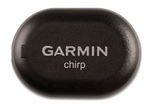A Review of Garmin chirp: Specifications & Compatibility

Garmin has devised its chirp primarly for outdoor geocaching, but the product finds use for many other creative applications as well. It can, for instance, tag items for easy retrieval in large warehouses or yards, tag valuables for easy tracking, or simply serve as a key chain that would never get lost. Another possible use is as a checkpoint in adventure racing. It works by transmitting pre-programmed information to a compatible Garmin GPS device within the range of chirp, and recording the number of visitors to its coordinates.
Specifications and Design (5 out of 5)
The chirp is a sleek and handy little instrument slightly larger than a capsule, easy on the hands and attaches easily on most items and places. The product measurements are 1.3 inches (3.3cm) x 0.9 inch (2.3 cm) x 0.3 inches (0.7cm), and a weight of 1 ounce (28 grams).
IPX7 waterproofing ensures that chirp will still work when underwater for a up to a meter for 30 minutes, or in the rain. Garmin, however, does not recommend submerging or burying the chirp, so there is no way to test this out unless the chirp gets under water by accident.
The product comes with a replaceable CR2032 lithium coin cell battery that Garmin claims will last for a year on continuous use in cold weather. One good feature is the message that appears on the GPS Handset when battery runs low.
The product packaging includes instructions and an adhesive disk to fix the chirp. Overall, the chirp scores on appearance and design.
Compatibility (2 out of 5)
Garmin chirp uses the ANT+ protocol and remains compatible with Garmin GPSMAP (62s, 62st, 78s, 78sc), Oregon (300, 400t, 4001, 400c, 450, 450t, 550, 550t, and x50) and the Dakota 20.
The chirp, however, is not compatible with other Garmin GPS handsets such as Dakota 10, Oregon 200, GPSMAP 62, GPSMAP 78, all GPSMAP 60 and 76 models, and all eTex and nuvi models, that do not use the ANT+ technology, besides non Garmin GPS devices. Surprisingly, even Garmin Colorado, which works in the ANT protocol does not seem to find support. This is a major drawback of the chirp, which can limit its widespread application.
Older Garmin geocaching units compatible with the chirp, will need to update the GPS software before using the chirp. This process usually goes on smoothly with little or no bugs, but may face some obstacles depending on the type of handset and the settings.
The chirp operates via ANT+ through the newly created ANT+ Geocache Node Device Profile, which is available and accessible to hundreds of companies. So theoretically, any ANT+ vendor should be able to develop an iPhone app or Android app that could operate with chirp.
Performance (3 out of 5)
The chirp has a declared range of 32 feet (10 meters),

but in performance, the range is much less. The chirp seems to work best when there is an unobstructed view, for a clear view delivers a range of about 20’ to 25’. Placing the chirp high up seems to improves the range by a few feet. Obstructions, however, reduce the range drastically, even up to 5 feet. Sealed metal containers such as ammos completely block the range.
The chirp constantly transmits information to any compatible GPS within range that has enabled chirp searching, and the chirp automatically downloads the name, serial number, message, coordinates, number of visits, low battery warning, and last visit to such GPS devices within about ten seconds after coming in range.
One limitation is that only the chirp coordinates save as special waypoints, without preserving the message. Even the chirp coordinates overwrite when encountering the next chirp. As of now, there is no way to save the data of each chirp permanently.
Ease of Use (5 out of 5)
Enabling the chirp on GPS is easy and an automated process. (Setup>Geocaches>chirp Searching). The product comes with a blank memory, programmable with any compatible GPS that connects to it.
Programming the chirp (Setup>Geocaches>Program chirp) is equally easy and takes less than a minute. This process involves assigning a name (maximum 9 characters), adding any message (maximum 50 characters), and a set of coordinates. One option to do so is by gaining manual access to the easy to use menus through the GPS unit. Another option is by auto transfer using a waypoint or geocache. In the latter case, the chirp takes the name and coordinates of the selected waypoint or geocache.
Features (5 out of 5)
The Garmin chirp scores on its features. The chirp ensures a high level of security without compromising ease of use. The owner retains full control of the device and can password-lock the beacon.
The chirp remains locked to the GPS that programmed it, and reprogramming the chirp with another GPS requires the last 5 digits of the unit ID of the GPS that programmed and now “owns” the chirp. Effecting such a change over is hassle-free, however. Another way around this is the option that allows the GPS that programmed the Chirp to un-program it, putting the device back into its original un-programmed state.
Price to Value (4 out of 5)
At about $20 at Amazon, the Chirp is value for money, but more memory for about half the price would have made the product an excellent value for your money.
Overall Rating (4 out of 5)
The chirp ranks among the most creative new products launched by Garmin in recent times. It scores in its simplicity, appearance, and ease of use. The primary challenges the device needs to overcome for wide acceptance include memory constraints and extending compatibility to other GPS devices and the iPhone.
Chirp being a relatively new product, most performance parameters such as battery life, range and field durability are yet to withstand the test of time.
References
- Link to Product and Image: https://buy.garmin.com/